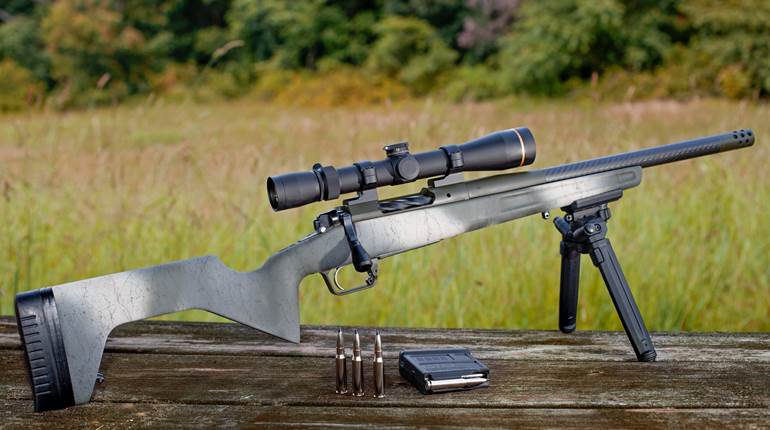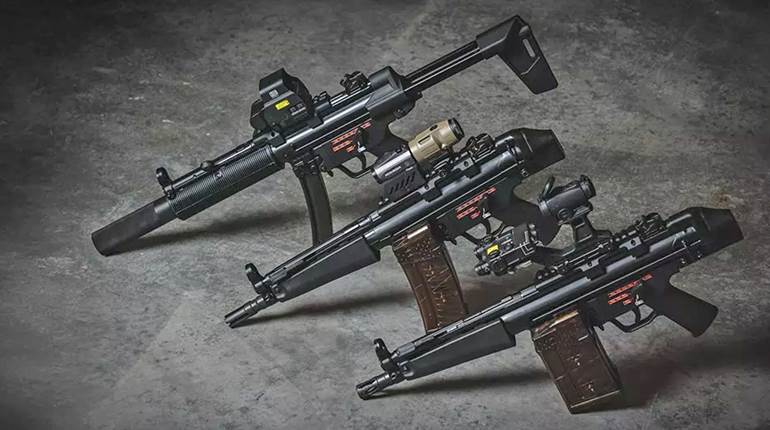
This article, "The National Match '03," appeared originally in the July 2003 issue of American Rifleman. To subscribe to the magazine, visit the NRA membership page here and select American Rifleman as your member magazine. Above: The firing member of the North Carolina National Guard team at Camp Perry in 1931 (r.) is shooting a standard M1903A1—an accurate rifle in its own right.
“You could step on the line today with one of the ’03 National Match rifles, shooting the ’06 cartridge, and you would not be outgunned by anybody.”
That’s the voice of authority from a legendary shooter who broke records using the ’03—records that still stand. Colonel Walter Walsh (USMC-Ret.), at 95, isn’t far behind the centennial mark himself. He’s perhaps the only shooter alive who has fired every 20th century service rifle fielded by American forces—from the Krag to the ’03 Springfield, the M1917 Enfield, the M1 Garand, the M14, the M16 and its civilian counterpart, the AR-15—in competition.
Walsh squeezed off his first competitive Camp Perry shot at the 1928 National Matches the New Jersey National Guard team. He remembers the Springfield rifle with great respect and fondness. “The ’03 was a beautifully made rifle. It was the very definition of precision. The National Match rifles had a smooth polished bolt—not blued or Parkerized. The action was a little smoother than you might find on the rifle in the company storeroom.
“But as far as the parts were concerned, it was essentially the same rifle you had in the hands of the ‘snuffy’—the guy in the rear ranks. From the mechanical standpoint, that private’s ’03 was as good as the rifle the top-notch shooter had at the matches. It may not have been as smooth, but it was basically the same rifle. That’s something we don’t have today, because we’ve fiddled and fooled around with these ‘mouse rifles’ we are shooting. Now, the match rifle is quite different than the rifle carried by the private in the rear ranks of today’s military.”
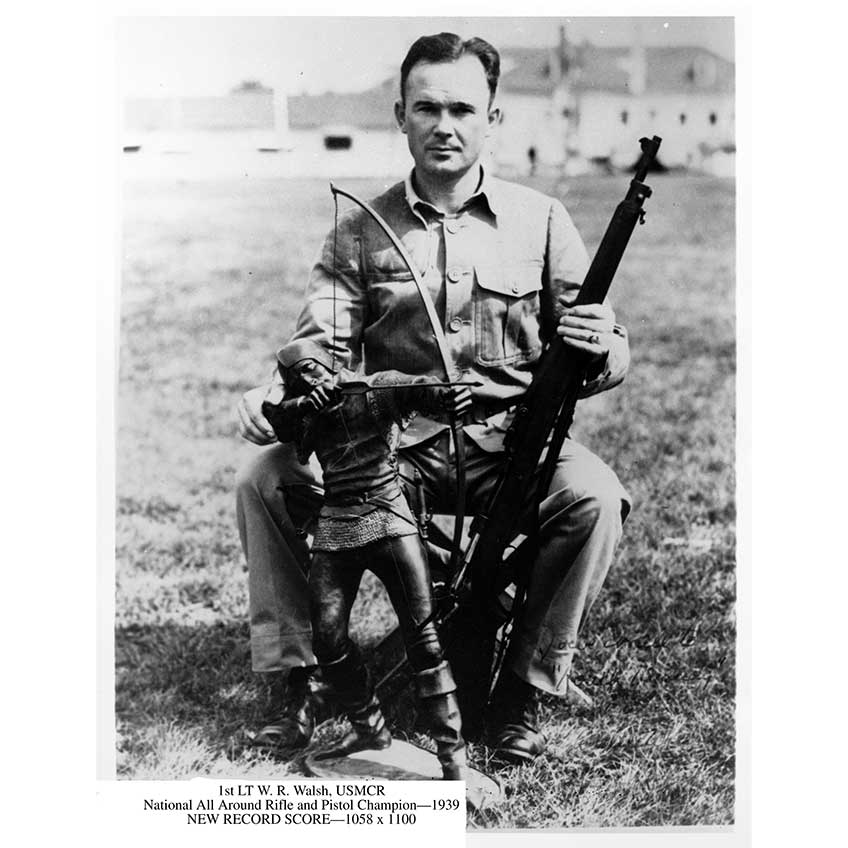
Although Springfield Armory, from the time of the M1903’s acceptance as the official battle rifle for all service branches, had taken great pains to create specially tuned M1903s for service teams, the birth of the true ’03 National Match rifle for sale to civilian shooters did not occur until its debut at Camp Perry, Ohio, during the 1921 National Matches.
One of American Rifleman’s predecessors, Arms and the Man, credited the creation of this superlative quality arm to then Maj. Julian Hatcher of the Army Ordnance Department (later American Rifleman’s Technical Editor) and Springfield Armory’s “Al” Woodworth. At their urging, the Armory “decided to make a special effort to supply the American rifleman with a service rifle whose equal had never before come from a government manufactury … .”

The product of that effort was, indeed, in every way a remarkable rifle. All parts manufactured were hand selected for fit. Particular attention was paid to internal polishing on the rails and surfaces that contacted the bolt body. Bolts were polished in the white. The most attention was paid to barrels, which were measured with “star gauges” for exact tolerances.
The July 1921 Arms and the Man described the results: “One look through the barrel will show a marked absence of tool scratches and a finishing polish which is seldom surpassed in rifles for match shooting. The barrels slug out remarkably true; and careful measuring shows a very slight gradual taper from chamber to muzzle … .” Star-gauged barrels were stamped with an asterisk shaped “star” punch on the muzzle crown.

Stocks on the 1921 National Match rifles were the same as the “S” stock on the standard ’03, with a straight grip and relatively short pull that caused many shooters of larger physical stature to crawl the stock—putting their noses in harm’s way. This was overcome by an option on NM rifles—reversing the flag safety to the right. Officially, the rifle was known as “Model 1903 NM.”
In 1924, Springfield added some subtle changes—making the reversed safety a standard item and milling off the distinctive knob of the cocking piece. The bright bolts were also electric-penciled with the receiver’s serial number, a practice that continued throughout production.

The standard NM rifle remained unchanged until 1929 when the “S” stock was replaced with the “C” stock, which had a full pistol grip, straighter drop and longer pull. The cocking knob also reappeared. This was the NM configuration until the end of its run in 1940. Its official nomenclature was “Model 1903A1 NM.”
From the collector’s standpoint, the ’03 National Match is in a class by itself. Capt. Steve Marvin (USN-Ret.), highly respected among knowledgeable U.S. military arms collectors, calls them “treasures.” He said, “You always hope, when one comes along, that it falls into the hands of someone who knows what a fine thing this is and really cares for it.”

Among the variations, the most valuable and sought after are two specifically designed to be sold to civilian shooters, both equipped with highly distinctive wood. The first, known as the “Style B” or “NB,” has a full stock based on that of the Model 1922M1 .22 target rifle. It has noticeable drop at the heel and a long, gently arched pistol grip squared on the end and has no grasping grooves.
Marvin saves his greatest praise for Springfield Armory’s National Match Special, which he described as “[T]he finest of them all. It was marvelously comfortable—just a superb stock." Rearward of the receiver, the wood is identical to the design of the “NRA sporter,” which was very high at the comb with a graceful hand-filling pistol grip.

Full at the butt, it came with a shotgun-type steel buttplate. These rifles were originally sold for $40.44 through the Director of Civilian Marksmanship. Both the National Match Special and the Style B were all drilled and tapped at Springfield for the Lyman 48 receiver sight, but on the NB no stock cut was provided.
Unlike the NB stock, the National Match Special wood could be purchased through the Director of Civilian Marksmanship (DCM). The difference in armory complete rifles and those put together using a stock bought separately is that the former are marked with an inspector’s cartouche and the circle “P” on the underside of the pistol grip.

All of the National Match ’03s were finely finished in a black Parkerizing process, which is something of a mystery among collectors. “It is a question as to how the finish was done,” said Marvin. One school of thought is they were Parkerized and subsequently blackened by a process that penetrated into the pores of the metal.”
In all, according to longtime American Rifleman Contributing Editor Lt. Col. William S. Brophy’s landmark work, The Springfield 1903 Rifles, total production of all ’03 NM arms was 28,907, with 19,950 manufactured between 1921 and 1928 and 8,912 with the “C” stock 1903A1 configuration.
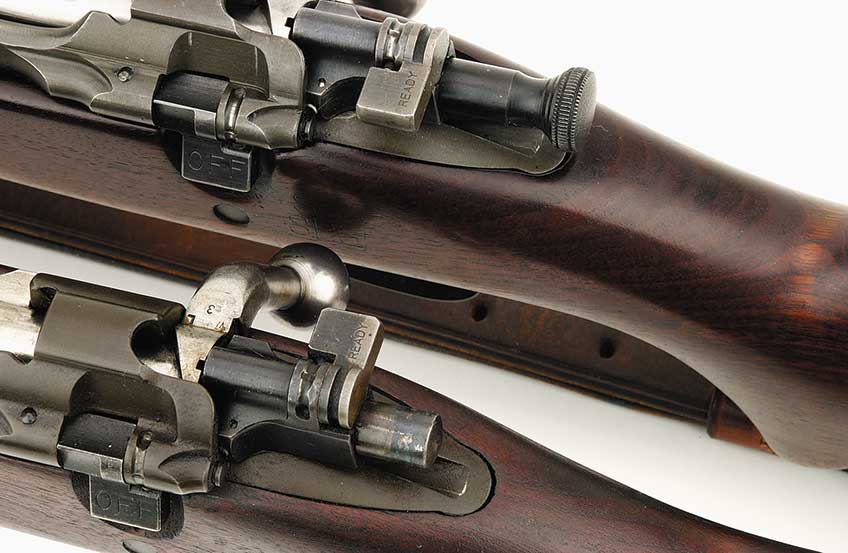
Marvin said that, remarkably, of the total 28,907 brand new rifles, Springfield overhauled 25,377. Most of these were issued to service teams, and saw considerable use in competition and practice. They were considered shot-out after a year’s use and reworked. Those arms were not just reconditioned, but totally rebuilt to the highest specs.
In terms of quality, they were indistinguishable from new production arms. Marvin said one distinguishing feature of the reworks was the addition of what was called “the Hatcher hole” (designed by Julian S. Hatcher)—a large gas-escape port drilled into the left side of the receiver. Each ’03 NM was tested for accuracy from solid rests or machine rests, with the average rifle printing a 2”, five-shot group at 220 yds., in what Arms and the Man declared, “[S]et an entirely new standard for accuracy.”

In terms of tuning up what Springfield had produced, Walsh said service armorers were mainly concerned with stock pressure at the fore-end. “The National Match ’03 was pretty much out of the box. The armorers bedded the rifles, and whatever bedding was done was just adjusting that piece of wood to get the barrel just a little loose in the front end coming to rest at six o’clock. They didn’t have fiberglass or anything like that. It was just tuned up a little bit.”
All ’03 NM rifles were equipped with a military ladder drift sight mounted just ahead of the receiver ring. It was identical to the issue sight,except that the 2,850-yd. “V”-notch at its top was dropped. The weakness of the ’03 in any of its National Match or service rifle configurations was that sighting system, which lacked any precise or repeatable adjustments in elevation or windage.

Competitors overcame this impediment with the aid of various micrometer devices the shooter rested on the sight in such a way as to make repeatable movements in minute-of-angle or sub-minute-of angle clicks. These “mikes” were not permanently attached to the rifle or the sights, but made for exacting adjustments, where sight settings could be perfectly doped.
The most popular was the O’Hare micrometer. “‘Paddy’ O’Hare, who shot with the New Jersey National Guard team back in the early 1900s, developed a very simple front and rear sight cover for the ’03,” Walsh said. “But best of all, he developed this O’Hare micrometer, which was as much a part of the shooter’s gear in a shooting box as was his ammunition. For anybody who was shooting top scores, it was absolutely indispensable.

“The O’Hare micrometer was one hell of a piece of work, and old Paddy O’Hare made a bundle on those mikes. At the time, they cost about five bucks. They were not expensive. They were very sturdy. Never heard of one that went bad.”
Perhaps the greatest feat in competition with the NM ’03 was by a civilian shooter, George R. Farr from Washington state, who took second-place honors at the 1921 Wimbledon Cup Match at Camp Perry. The course then, as now, required 20 shots from the prone position at 1,000 yds. Dick Culver—noted Marine shooter, DCM official, collector, shooter and prolific writer of historical articles on competitive shooting—probably knows more about the singular event than anyone. Dick’s father, a Marine Corps distinguished shooter, was there.

“Mr. Farr had drawn a National Match Rifle at Perry in 1921. He didn’t have a spotting scope, so he took an old pair of binoculars and sawed them in half and used that as a spotting scope. He drew the issue ammunition because it was free. He didn’t have any 1,000-yd. dope on the rifle. He’d just gotten some 600-yd. dope.
“Farr went over it with a sight micrometer. He laid down and his first shot was a four, which is unreal considering the elevation he had to put on. He caught the next one in the five-ring. He shot 20 consecutive bullseyes, and climbed out of position. The officials said, ‘You’re not finished yet.’” Farr was in a shoot-off with a Marine sergeant named Atkins, who was using a scoped Springfield firing Remington commercial ammunition.

The duel between Farr and the Marine lasted the rest of the day, under grueling Camp Perry conditions. Range officers provided issue service “tin can” ammunition. “When he got back into position, Farr shot until the light gave out and he could no longer see. In all, he ran 70 consecutive bulls-eyes before he dropped out. My daddy watched him do this. The funny thing was that this gentleman was 62 years old when he did this and didn’t wear glasses.”
“The officials said, ‘Mr. Farr, if you’d like to purchase this rifle, you can.’ It was about $41, and he didn’t have the money. All of the civilian teams got together and kicked in the money and bought the rifle for him, and a case of ammunition. They put a plaque on the side of the rifle.”

Culver said the Marine who bested Farr shot 76 consecutive bullseyes with his scoped rifle, but nobody remembers that. In fact, the following year, a trophy was presented to the high shooter in the Wimbledon match in honor of Farr’s remarkable accomplishment. The Farr Trophy has been a standard since then.
In the hands of competitors, how did the ’03 stack up to its counterparts? Walsh can answer that one. Among his accomplishments on the line, he even shot the M1917 Enfield in competition. He said for shooters with fading eyesight, the receiver sights on the M1917—“a good sturdy rifle,” he called it—were superior.

But the rifle that eclipsed the ’03 on the battlefield and ultimately on the range was the M1 Garand. Walsh was on one of the Marine Corps squads that first demonstrated the Garand at Perry in 1940. He didn’t care for it, or perhaps it didn’t care for him.
“After the war, the Marine Corps started a competition program in ’46,” Walsh said. “I was in China. I brought a crew back from the First Division. We shot the matches in Hawaii. I shot rifle and pistol.
“I shot pistol fairly well. With the rifle I didn’t get anything. We got to Quantico for the Marine Corps matches. And again, I shot the pistol fairly well, and won the pistol match. And I didn’t hit fiddle-dee-damn-dee with the rifle—the Garand. I’d go to the armorers, and see what they could do. They probably put it in a corner and said, ‘Wait for this guy to come back. Give him a string of BS.’

“But I didn’t do well at all with the M1. So being cold now, I got out some of my old stuff—the ’03 National Match—went back to 600 yds., and I had no trouble at all. I was now convinced that I could still shoot, it was just the Garand I couldn’t shoot.”
By the 1950s when the National Matches resumed in full swing following World War II, the ’03 was beginning to disappear on the line, replaced by the Garand, by then tuned to shoot as well as the venerable Springfield.

Perhaps the last military shooter to officially qualify with the National Match Springfield was an Army Second Lieutenant named Joe Roberts, who did it in 1963 while stationed in Germany. Roberts, of course, is a long-time NRA professional, former American Rifleman managing editor and a fixture at the press office at Camp Perry.
“Right after I got to Germany, the Army was in the process of switching to the M14. I’d gone to the range with my company and was complaining to the company commander about the lousy level of marksmanship and he asked, ‘Can you do better?’ I said, ‘Yes, sir.’ And he said, ‘I bet you can’t outshoot me.’
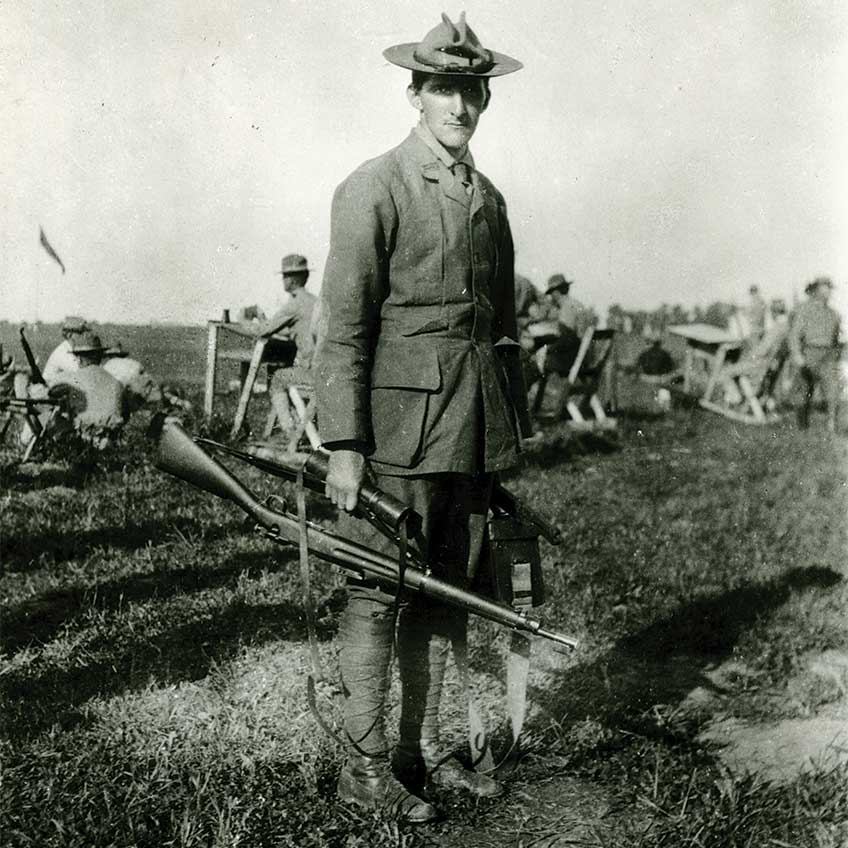
“I asked if I could use my own rifle, and he asked if it used issue ammunition. I beat him by two points and had to clean the known-distance course to do it.”
Roberts acquired his M1903A1 NM when he was in high school. He picked it off the rack from scores of run-of-the-mill M1903 and M1903A3 rifles at Alexandria, Va.’s Ye Old Hunter gunshop in the salad days of the military surplus boom.

“That rifle had spent World War II in the 77th Construction Battalion. I know that, because whomever was issued the rifle scratched it in the stock,” he said. Like everybody else who has ever handled the NM ’03, Roberts considers it exquisite in every respect.
One of the friendly arguments between collectors is over the method of finish used by Springfield Armory which gave the rifle’s metalwork it’s peerless quality. Were the M1903s NM rifles sandblasted?
For his part, Marvin said, “If they did sandblast, they must have used star dust.”













